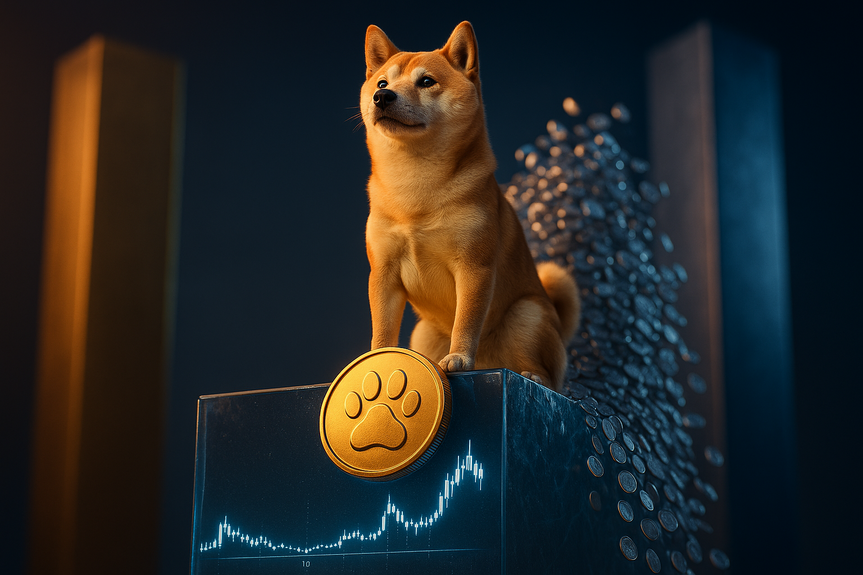Cathie Wood buys crypto stocks and pins five underpriced names investors should watch for upside now.
Cathie Wood buys crypto stocks as prices slide, adding Block, Circle, Coinbase, Robinhood, and Bullish across Ark Invest funds. The firm spent tens of millions while the crypto market fell and bitcoin cooled from its recent peak. Here are the key numbers, the strategy behind the buys, and five bargains to watch now.
On Tuesday, Ark Invest leaned into weakness across crypto-exposed names. The firm disclosed fresh buys in Block, Circle Internet Group, Coinbase, Robinhood Markets, Bullish, and even its own spot bitcoin ETF. The tactic fits Ark’s high-conviction approach: build positions when the market is fearful, then hold through cycles. It is a simple plan, but it demands discipline and clear time horizons.
Bitcoin has pulled back sharply from its all-time high set six weeks ago. Liquidity is thin. Macro signals are mixed. This has hit crypto-related stocks hard. Yet Ark added to positions that it already sees as core to its innovation thesis. The fund now counts Coinbase as a top-four holding in ARKK by weight, and it lifted several smaller positions on the dip.
Why Cathie Wood buys crypto stocks on weakness
Ark Invest runs an active strategy around long-term themes. It seeks out companies that can gain share from large, slow-moving incumbents. When prices fall but the thesis stays intact, the team buys more. In this case, Ark focused on platforms that connect users to digital assets, payment networks, and trading.
The flows on Tuesday show this mindset in action:
Coinbase sits near the top of ARKK’s portfolio at about $391 million in value, or roughly 5.22% of the fund.
Circle stands at about $179 million in ARKK, near 2.39% of the portfolio.
Block accounts for about $85.2 million in ARKK.
The timing lines up with broad weakness:
Block rose 2.96% on the day to $63.69 but is still down 20.54% over the past month.
Circle fell 3.62% to $70.11 and sits 51% below its price one month ago.
Coinbase dipped 0.72% on the day and is down 30% in a month.
Bitcoin trades near $87,948, well below its recent high near $126,000.
When Cathie Wood buys crypto stocks during selloffs, she signals long-term confidence. The bet is that utility, adoption, and recurring revenue will matter more than near-term price swings. It also reflects the belief that this sector consolidates gains after sharp rallies and that the next leg up rewards those who built positions early.
The fresh buys and what they signal
Ark spread purchases across several funds, led by ARKK:
$13.5 million in Block, Inc. shares.
$7.6 million in Circle Internet Group.
$3.86 million in Coinbase Global.
$1.52 million in Bullish.
$878,794 in Robinhood Markets.
$2.8 million in the Ark-21Shares spot bitcoin ETF.
This distribution shows a barbell. On one side are scaled platforms with strong brand and network effects (Coinbase, Block). On the other are smaller or newer positions with higher potential torque (Bullish, Robinhood). The ETF buy indicates Ark also wants beta to bitcoin itself, not only equity exposure.
Five bargains to watch now
1) Block (SQ): Payments, Bitcoin, and a leaner cost base
Block blends a seller ecosystem (Square) with a consumer ecosystem (Cash App). It also has Bitcoin exposure through Cash App and related services. The core idea is simple: keep onboarding small businesses and consumers, drive engagement, and monetize payments, banking-like features, and financial tools.
Why it looks attractive now:
Cash App’s large user base gives Block a foundation to cross-sell new features.
Management has emphasized sharper cost control and operating leverage.
Bitcoin’s long-term adoption can add to engagement and gross profit over time.
Key risks:
Competition in payments remains intense, both from fintechs and big banks.
Consumer spending could slow if macro conditions weaken further.
Crypto-related revenues are cyclical and can amplify volatility.
What to watch:
Monthly active users and Cash App monetization trends.
Margin progress as growth investments meet cost discipline.
Product velocity: new features that increase user stickiness.
2) Circle (CRCL): USDC scale and compliance edge
Circle issues USDC, a regulated, fully reserved stablecoin designed for payments, settlements, and on-chain commerce. The growth path hinges on two levers: expanding real-world use cases and preserving trust through compliance and transparency.
Why it looks attractive now:
USDC supports fast, low-cost transfers across chains, and enterprise demand can rise as on-chain finance matures.
Circle’s focus on reserves and audits is a differentiator in a sector where trust matters.
Cross-border settlements and fintech integrations can widen adoption.
Key risks:
Regulatory shifts could change stablecoin rules across markets.
Competition from other stablecoins and bank-backed digital money.
Crypto market cycles can slow on-chain activity and fee growth.
What to watch:
USDC circulation trends and chain coverage.
Regulatory clarity in the U.S. and major regions.
Partnerships with payment firms, banks, and wallets.
3) Coinbase (COIN): Beyond trading toward subscriptions and custody
Coinbase remains the leading U.S.-regulated crypto exchange and custody provider. It also offers staking, derivatives, and institutional services. The long-term goal is to reduce reliance on trading fees and grow subscription and services revenue.
Why it looks attractive now:
Institutional custody and prime services can scale with ETF flows and corporate demand.
Subscription revenue (custody, blockchain rewards) can smooth cycles.
Regulatory clarity around spot bitcoin ETFs has strengthened Coinbase’s position as a trusted infrastructure partner.
Key risks:
Fee compression if competition heats up in retail and derivatives.
Regulatory actions can affect product scope, especially staking.
Market drawdowns reduce trading volumes and sentiment.
What to watch:
Mix shift toward subscriptions and services.
Institutional assets under custody and prime brokerage traction.
International expansion and derivatives progress.
4) Robinhood (HOOD): Retail finance with a growing crypto piece
Robinhood serves active retail users across stocks, options, and crypto. It earns from trading, net interest income, and other services. Crypto is a smaller piece than at dedicated exchanges but can be a swing factor in bull and bear cycles.
Why it looks attractive now:
Net interest income gives a cushion when trading slows.
Crypto engagement can rebound quickly in upcycles, raising activity and ARPU.
Product expansion, including retirement accounts and futures, adds breadth.
Key risks:
Regulatory scrutiny across brokerage and crypto offerings.
Retail activity is cyclical and sensitive to headlines.
Monetization depends on active users and product mix.
What to watch:
Monthly active users, ARPU, and cohort retention.
Crypto trading share compared to peers.
Roadmap execution on new asset classes and geographies.
5) Bullish: Institutional-first exchange thesis
Bullish targets a more institutional audience with a focus on liquidity, compliance, and reliable execution. In a market that has seen several exchange scandals and outages, a conservative posture can appeal to funds and market makers.
Why it looks attractive now:
Institutions value robust custody, governance, and regulatory alignment.
Liquidity attracts liquidity: deeper books can improve spreads and volumes.
A measured listing strategy can reduce risk while building trust.
Key risks:
Entrenched competitors already serve large institutions.
Volume concentration among top exchanges can be hard to break.
Market slowdowns can delay adoption.
What to watch:
Institutional onboarding, volumes, and market share.
Security, uptime, and transparency metrics.
New listings that bring fresh liquidity without raising risk.
What the price action tells us
The tape shows a classic post-peak reset. Bitcoin is well off highs. Liquidity is thinner. Spreads widen. Beta names fall faster than the asset they track. In that window, Ark raised exposure. The team then balanced core holdings with satellite bets that can outrun in the next uptrend.
A few signals stand out:
ARKK’s Coinbase stake near 5.22% shows conviction in crypto infrastructure.
Circle at 2.39% supports the stablecoin and payments thesis inside the portfolio.
Block’s position fits the “consumer plus merchant” rails story with crypto as an optionality kicker.
This approach is coherent. Coinbase benefits from institutional flows and custody. Circle benefits from stablecoin use in payments and settlements. Block benefits from fintech adoption and engagement. Together, they create multiple paths to growth if digital assets continue to integrate with mainstream finance.
Risks and catalysts to track next
Near-term volatility will remain high. Macro uncertainty can dent risk assets. But catalysts also loom. The balance of risks and drivers will steer outcomes for these five bargains.
Main risks:
Regulatory changes could affect stablecoins, staking, and exchange products.
Liquidity shocks in crypto can amplify drawdowns and spreads.
Competition from global exchanges or big tech in payments.
Consumer weakness could slow engagement across fintech apps.
Potential catalysts:
Clearer stablecoin rules in major markets, expanding USDC’s use cases.
Institutional inflows into crypto ETFs and custody platforms.
Product launches that deepen user engagement and raise ARPU.
Operating leverage as companies manage costs while revenues recover.
How to think about positioning
Investors often face a hard choice after a drawdown: wait for “confirmation,” or average into weakness. Ark chose the latter. That does not mean the bottom is in. It means the team weighed the fundamentals, the balance sheets, and the network effects, and decided the risk-reward looked favorable.
A simple framework for evaluating this setup:
Separate long-term thesis from short-term price action.
Focus on unit economics: users, take rates, margins, and retention.
Watch balance sheets: cash, liquidity, and runway for innovation.
Track regulatory milestones that expand or limit product scope.
Avoid concentration risk: consider position sizing and diversification.
If you monitor these signals, you can form your own view on whether the current prices reflect temporary fear or deeper structural issues. For now, Ark’s actions suggest it sees the former in these names.
Bottom line
This week’s trades show a consistent strategy: buy high-conviction names when fear is high. Ark added to Coinbase, Circle, Block, Robinhood, and Bullish while also topping up its own spot bitcoin ETF. The market may stay choppy, but strong platforms can gain ground when the cycle turns. That is the bet on display when Cathie Wood buys crypto stocks—and it puts these five bargains squarely on the watchlist.
(Source: https://www.theblock.co/post/380482/ark-invest-block-circle)
For more news: Click Here
FAQ
Q: What recent crypto-related stocks did Ark Invest buy?
A: Ark Invest purchased $13.5 million of Block shares, $7.6 million of Circle Internet Group, and $3.86 million of Coinbase shares, and it also added $1.52 million in Bullish, $878,794 in Robinhood Markets, plus $2.8 million in its Ark-21Shares spot bitcoin ETF. Most of these buys were made across its ETFs, led by the Ark Innovation ETF (ARKK).
Q: When Cathie Wood buys crypto stocks, what strategy does Ark follow?
A: Ark runs an active, high-conviction, long-term thematic strategy that adds to positions when prices fall but the investment thesis remains intact. The team builds positions on weakness and holds through cycles, relying on discipline and clear time horizons.
Q: How large are Coinbase, Circle and Block holdings within ARKK?
A: Coinbase is about $391 million in ARKK, representing roughly 5.22% of the fund, Circle totals about $179 million or 2.39%, and Block accounts for about $85.2 million in the ETF. Those weights underline ARKK’s meaningful exposure to crypto infrastructure and payments within the fund.
Q: How did bitcoin’s recent price action and market conditions factor into Ark’s buys?
A: Bitcoin pulled back from its recent high near $126,000 to trading around $87,948, and the market was hampered by thin liquidity and mixed macro signals, which pressured crypto-related stocks. Ark used that weakness and the resulting price declines as an opportunity to add to names it views as core to its innovation thesis.
Q: Which five bargains does the article suggest watching after Ark’s purchases?
A: The article highlights five bargains to watch: Block (SQ), Circle (CRCL), Coinbase (COIN), Robinhood (HOOD), and Bullish. Each company is described for its role in payments, stablecoins, exchange infrastructure, retail finance, or an institutional exchange thesis.
Q: What main risks should investors monitor for these crypto-related stocks?
A: Main risks identified include regulatory changes affecting stablecoins, staking and exchange products, liquidity shocks that can amplify drawdowns, competition from global exchanges or big tech, and consumer weakness that could slow engagement. These risks can affect fee growth, revenues and market share across the highlighted companies.
Q: What catalysts could drive a recovery for the stocks Ark bought?
A: Potential catalysts include clearer stablecoin rules in major markets, institutional inflows into crypto ETFs and custody platforms, product launches that deepen user engagement and raise ARPU, and operating leverage as companies manage costs while revenues recover. The article notes these factors could steer outcomes for the five bargains.
Q: How should investors frame their positioning after Ark’s recent buys?
A: The article suggests separating long-term thesis from short-term price action, focusing on unit economics like users, take rates, margins and retention, and watching balance sheets and regulatory milestones. It also notes Ark chose to average into weakness rather than wait for confirmation, but cautions that this does not guarantee the bottom is in.







